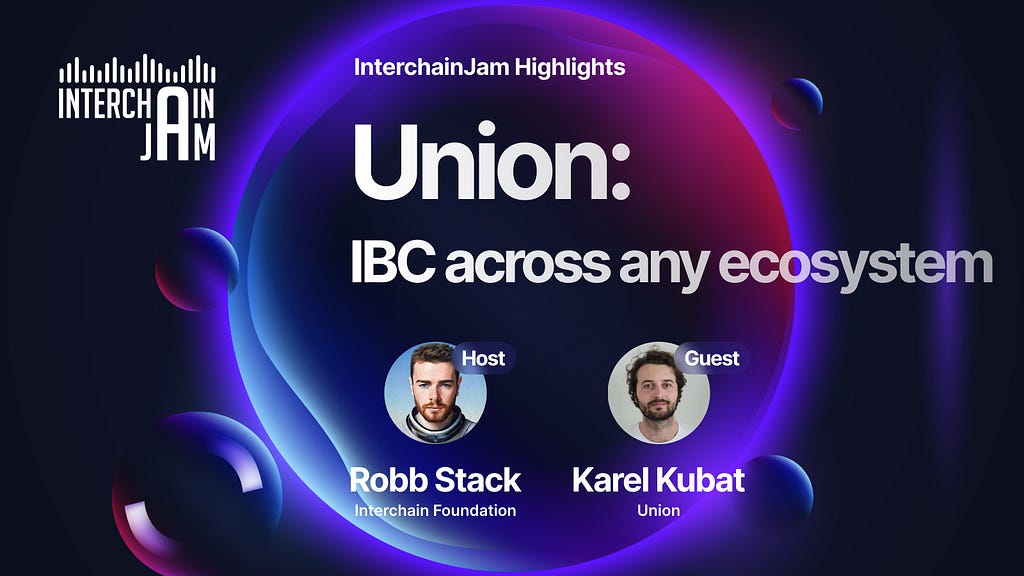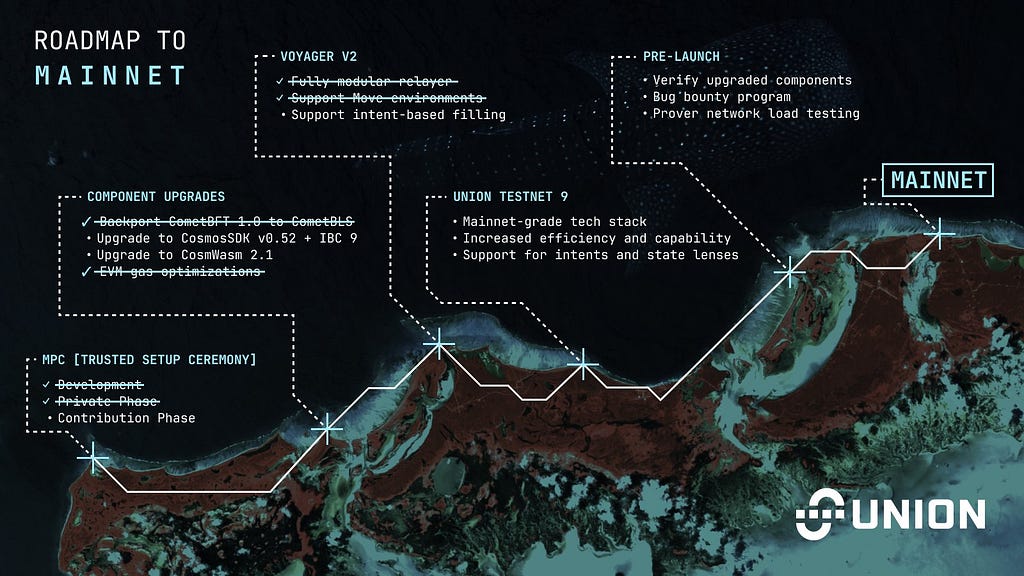Latest news about Bitcoin and all cryptocurrencies. Your daily crypto news habit.
Interchain Jam Highlights — Union: IBC Across Any Ecosystem

Interchain Jam Highlights — Union: IBC Across Any Ecosystem recaps the live X session hosted by the ICF’s Robb Stack. In this edition, we hear how Union leverages its modular tech stack including modified consensus engine CometBLS, an extended version of IBC, and zero knowledge (ZK) proof technology to enable IBC across any ecosystem. Founder Karel Kubat discusses Union’s journey so far, why they chose to build with the Interchain Stack, and what’s coming up on the road to mainnet. Check it out.
Union — The Modular ZK Interoperability Layer
Union, a cutting-edge modular zero-knowledge (ZK) interoperability layer, is focused on expanding the interchain by connecting the next generation of blockchains and rollups across any ecosystem using efficient ZK cryptography and consensus verification to make protocols fast, trustless, and permissionless. Messages are verified using ZK proofs, adding an extra layer of security.
Union is built on Cosmos SDK and integrated with an extended version of IBC, swapping out the CometBFT consensus engine for a modified version, CometBLS, that speeds up proving and achieves IBC efficiently on external ecosystems. Founder of Union Karel Kubat is a contributor to Cosmos and the broader interchain, and previously worked in the Polkadot space, and “basically any ecosystem that believes in horizontal scalability.”

He says, “At Union, we do an interop protocol that’s ZK-based and IBC compatible, as well as extendable IBC, so we have our own custom channel versions, where we’ve extended the protocol to do a lot of other cool things.”
ZKP proofs can be generated by any consensus engine but can take a long time to do (five to six minutes) which impacts the user experience and increases the cost. Karel says, “That impacts UX for the end user because, in the lifecycle of a trustless bridge message that we send, a portion is taken up by generating a zero-knowledge proof. That adds latency that you cannot really avoid and also increases the cost.”
By swapping out the consensus engine for the customized CometBLS, Union can make proving cheap and fast for improved UX and reduced underlying costs. “It changes how data versus design blocks are proposed, as well as the hashing algorithm that we use in the stack to make it more ZK-friendly overall,” he explains.
Why Union Decided to Build with the Interchain Stack
“I’m a big believer in not just modular as a thesis for scaling blockchains, but horizontal scalability, many chains communicating as a swarm of microservices.” He speaks about his experience building in the Polkadot ecosystem, and admits that development was “a bit more cohesive with one central chain connecting everything and exactly the same stack everywhere.” However, “it turned out to actually not work that well.”
Karel says the Polkadot tech stack led to “a lot of bottlenecks across the entire ecosystem where Parity itself became a limit on the total scaling factor.” The Union team switched to the Interchain Stack because:
“The interchain to me represented much more how the internet functions itself, where individual teams can basically push certain verticals themselves, and innovate much more, and differ from each other as well… There’s a lot of innovation going on and a lot of different opinions… I think it’s long-term, the most resilient.”
Karel concedes that ecosystems “where you have one team pushing it forward” tend to excel in the short term, but “long-term resilience comes when you have a lot of individual teams both competing on tech and product against each other to make the UX better for everyone.” He adds:
“Over the last six months, the Cosmos SDK as a stack has been making tremendous strides to once again be truly the best stack to build on. We see chains being able to do 200 millisecond block times, and hopefully, we’ll see better block STM support coming in too. And with that, I think once again, it’ll take the crown as the most performant blockchain stack that you could use and with a lot that you get out of the box with it.”
What Union Aims to Achieve
What’s Union’s mission and what does the team hope to achieve by connecting many blockchains, rollups, and applications? “The vision for Union aligns with why we founded Union originally,” Karel says. “Right now, if you build a chain on L2 and you want to get connected to other major ecosystems, it’s almost like getting an HTTPS certificate back in the 90s.” He goes on to say that projects often have to wait weeks or even months for a bridge provider to support them.
“What I want Union to be known for is reducing what right now is a six-month-long journey to basically the first two hours of setting up your chain. I want it to be that once you’ve scaffolded your Cosmos SDK chain or whatever other stack you’re using, you can already connect to Union mainnet and be live connected to everything else.”
Karel concedes this won’t happen overnight. Union has a long-term vision and there is still work to be done to improve the tech. “We need to improve on latency, 20-second latency between messages end-to-end in the interchain, if we want to make the horizontally scaled stack better than Solana, and still make it feel like one whole… That’ll make this full-stack truly work for the user. That’s a secondary objective for Union.” He continues:
“Mainnet is like the first three to four percent of what I want Union to be. We basically internally have ideas to cover the next five to 10 years of Union development.”
The impact that Karel wants Union to have is that people from other ecosystems no longer realize that something is Cosmos underneath. He says:
“I want them to just say, this is a great DEX or a great new ecosystem, and they don’t realize that they are actually bridging into Cosmos SDK stack from Ethereum. They just know it took 10 seconds to get their money there. If the bridge time is the same as waiting for an Ethereum block to see your transaction included, that’s freaking amazing.”
Harnessing ZKP for Efficient Interoperability
Union uses ZK proofs to update IBC’s live clients cost-effectively and efficiently, especially when interacting with EVM-based blockchains, which incur high gas costs. Karel explains, “A live client update involves doing some cryptography, a whole host of signature verifications, and a bunch of other things, which is relatively expensive to do on-chain, especially in the EVM itself.”
ZKPs enable Union to make the on-chain gas cost low and the off-chain hardware cost slightly higher. “In the case of Union, we do a live client update every 30 seconds or something, so we really need the ZKP tech to make this work. Otherwise, it just doesn’t scale at all and the fees you need to charge the users become too high.”
How does Karel believe the mainnet launch of Union will impact the broader adoption of IBC? “I think that Union will be launching at exactly the right time. We have a few amazing partners including Agoric and a lot of new use cases that are unlocked by having trustless interop and more sophisticated orchestration on top…
“I’m really excited about unlocking interop to all major ecosystems for anyone building a new chain… Being able to just get access to every single major ecosystem without needing to pay a million a year to some bridge protocol or needing to do a six-month-long integration. That’s what really excites me.”
Enabling Permissionless Composability
Union seeks to achieve permissionless composability, meaning that anyone can open a connection to Union and all the chains it supports without submitting a governance proposal or speaking with the Union team. Karel explains, “They just boot up a chain locally, open the channel, and run a prover. That’s the maximum level of permissionless you can get…
“That’s the same level of permissionless that contracts on Ethereum have when they want to integrate Uniswap. I don’t need to speak with Uniswap Labs if I want to integrate one of their pools into my protocol. That’s the level that we want to achieve for people who are building a modular stack.”
The sovereignty and autonomy that the Interchain Stack provides have been indispensable to developing Union, allowing the protocol to make its own design choices and customize the chain to its needs by swapping out CometBFT with CometBLS and extending IBC.
“Our IBC implementation differs from upstream IBC. We’ve made some extensions that were fully compatible backwards but we do have our additions to the stack and that’s what’s amazing about it. That makes us work so well. The fact that we can both iterate independently and still benefit from having the same stack.”
What Else Is Union Working On?
A Private Clearing Layer
The team is working on a new clearing layer on top of Union to create an EVM-compatible Rollkit L2 that’s fully private over shared states; a private clearing layer designed for clearing large amounts of funds. Currently, large onchain operators from market makers to OTCs, exchanges to wallets, periodically need to rebalance their wallets and everything is publicly visible onchain, which discourages traditional financial participants from engaging with blockchain.
“The current clearing layers are fully public,” Karel says, “You can see all assets close, which makes no sense in the traditional financial world as it leaks information to competitors. If crypto wants to actually serve big banks and TradFi, we need a private clearing layer with fast interop underneath… that will probably form the first extra network on top of Union, which fits in with other endeavors that we’re doing, such as our intent-based bridging layer.”
New Integration and Collaborations

Union recently announced a collaboration with Stargaze to bring Ethereum NFTs to the interchain, and integrations with Berachain and Movement Labs. Karel says, “Those two I really find exciting because it’s a brand new tech stack. It’s really pushing the envelope on all VM tech consensus tech.”
Union has also integrated successfully with Scroll native zkEVM L2 and Arbitrum L2, securely bridging an optimistic rollup. Karel is also excited about working with Native to bring Bitcoin derivatives “to every single interchain chain.” He enthuses:
“I’ve never been more bullish, to be honest, than I am now.”
The Union road to mainnet has begun and you can find out how to participate in their Trusted Setup Ceremony here or follow Union on X for more updates and information. Be sure to tune in to the next live Interchain Jam Session, It’s Here, It’s Migrating, It’s Launching on Thursday, October 14 at 3 PM UTC to hear from Lava, POKT Network, and Native about their journeys to the interchain.
Interchain Jam Highlights — Union: IBC Across Any Ecosystem was originally published in Interchain Ecosystem Blog on Medium, where people are continuing the conversation by highlighting and responding to this story.
Disclaimer
The views and opinions expressed in this article are solely those of the authors and do not reflect the views of Bitcoin Insider. Every investment and trading move involves risk - this is especially true for cryptocurrencies given their volatility. We strongly advise our readers to conduct their own research when making a decision.